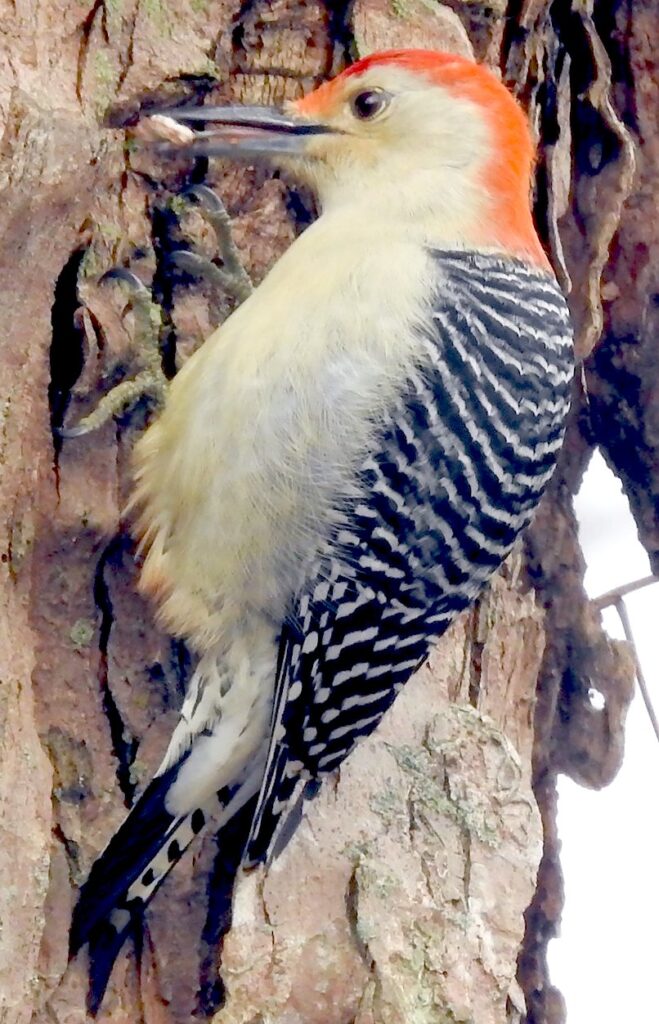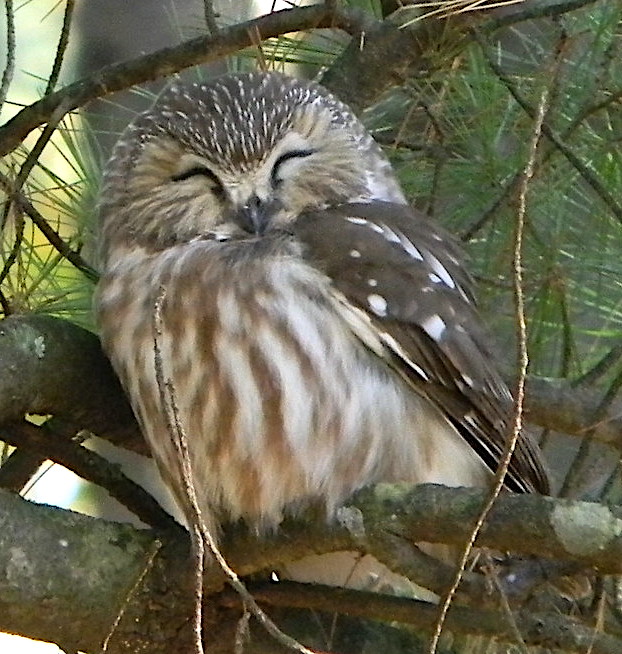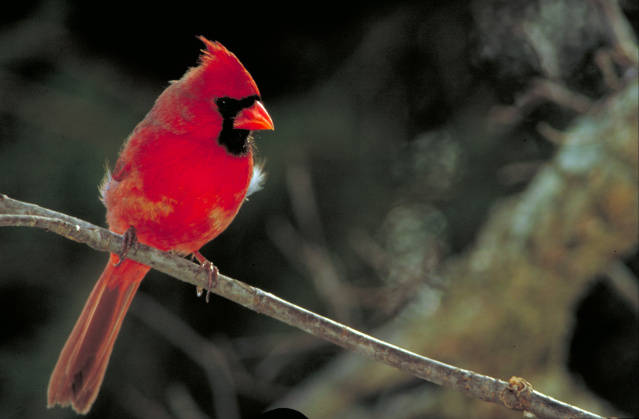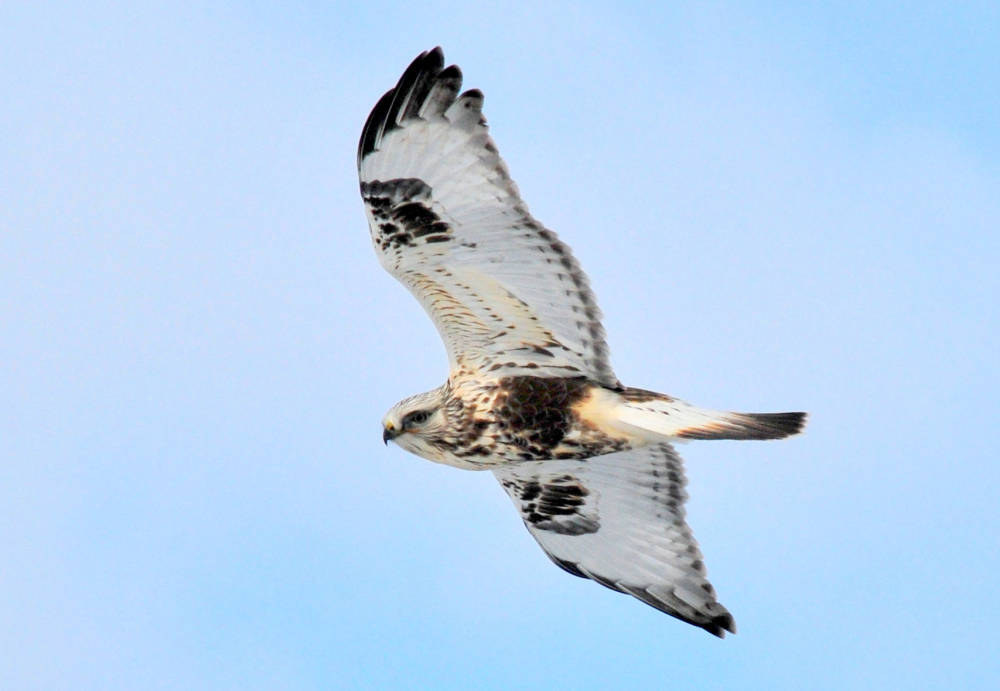Here’s a description of some of the birds that spend winter in southern Wisconsin, including the natural areas of Capital Springs Recreation Area. All of the birds listed below have been seen at the park, taking advantage of the wide variety of habitats (woods, prairie, open creek water, marsh) that provide both shelter and food during winter months. You may also find many of these birds at your winter feeders.
Some species are year-round residents to southern Wisconsin, such as the Blue Jay and Hairy Woodpecker. Other species migrate here every winter, such as the Dark-eyed Junco and American Tree Sparrow. Other species are consistently nomadic, traveling regionally or greater distances every winter (such as the Red-headed Woodpecker) to find food. Perhaps the most interesting group is those that come here through irruptive migration, traveling medium to long distances only some winters when food is scarce in breeding grounds. These birds include but are not limited to some species of owls, finches, and crossbills.

We have two species of nuthatches to enjoy here in the winter, both of which visit feeders well stocked with suet, black sunflower and peanuts. They are aptly named for their behavior of cramming a nut into bark and whacking it to “hatch” the food inside.
WHITE-BREASTED NUTHATCH
This common bird is a year-round resident in almost all of its territory in the U.S. and Canada. Even with a small stature, it is easy to identify in a woodland. Listen for loud nasal honking, and look for a blue-gray bird with white chest, busily moving up, down, and all-around tree trunks and branches. It tends to flock with other woodland species to better identify food and to protect itself from predators. Males have a dark crown (in photo), females a gray crown.

RED-BREASTED NUTHATCH
This nuthatch of coniferous woodlands is a regular migrant into southern Wisconsin – many begin migration as early as July. Keep an eye out for this special bird at winter feeders as it is a treat to watch busily working around a tree, grabbing food way too big to eat in one bite, and caching food way for later. Smaller than the White-breasted Nuthatch, note the distinctive pinkish chest, black eye line, no neck, and long bill. Males have a dark cap and females a grayish cap (in photo).

RED-BELLIED WOODPECKER
A busy Wisconsin woodpecker, the Red-bellies is a common sight in deciduous woods. It’s hard to miss by either sight or behavior. By sight, the Red-bellied is a medium-sized bird (a bit smaller than a crow) featuring a boldly-patterned black and white back, creamy chest with flushes of orange-red (it may not always be visible), and long, strong bill. Males have an orange-red crown and nape (in photo), and females have a orange-red nape with a gray crown.
By song, the Red-bellied is chatty, producing loud churr calls while swinging from branch to branch and feeder to feeder – even hummingbird feeders in summer. Like all woodpeckers, it calls also by drumming on trees and other surfaces. The Red-bellied caches food and uses bark crevices to cleverly hold nuts for cracking.

RED-HEADED WOODPECKER
A stunning woodpecker with a deep red-blue, rounded head and bib, the Red-headed is a welcome guest to your suet and bird feeders. It’s about the same size as the Red-bellied and Hairy Woodpeckers, and makes a racket in the woods, similar to the Red-bellied. It also drums frequently to communicate with other birds. Males and females are identical.
A much more rare sight than most other Wisconsin woodpeckers, the Red-headed migrates regionally in search of oak acorns in winter. Because individuals may wander widely, you may not see it consistently.

HAIRY WOODPECKER
The Hairy Woodpecker is a common, year-round Wisconsin woodland bird patterned in black and white. The female and male look identical except for one feature: the male sports a red patch on the back of its head (this photo is of a female). The Hairy is about the size of a Robin and makes frequent peek and whinny calls.
The Hairy is frequently confused with the smaller Downy Woodpecker (below) which has almost identical black and white feather patterning. To distinguish the two species, look at the bill: the Hairy has a bill about as long as the width of its head, while the Downy has a very short bill. Also, the Hairy’s calls are lower in tone and somewhat stronger. Both use drumming on trees and other objects as a means of communication (many other woodpeckers also perform this behavior).

DOWNY WOODPECKER
The Downy Woodpecker is also a common, year-round Wisconsin woodland bird patterned in black and white. Males and females look the same, except for the red patch on the back of the male’s head (see photo). This bird is smaller than the Hairy Woodpecker, about the size of a large sparrow.
The short bill – about half the size of the width of its head – distinguishes it from the Hairy. Both birds come readily to bird feeders, suet feeders ,and peanut butter feeders. The Downy makes rapid squeak calls, similar to the Hairy, but the calls are higher pitched and a bit softer.

HORNED LARK
Horned Larks that breed in Canada and the far northern portions of the United States migrate to areas throughout the United States for winter. Those individual birds that breed here in summer tend to stay year-round. Horned Larks are tough birds that withstand harsh winter wind gusts and snow – look for them in flocks on the edge of harvested fields or perched on stubby corn stalks.
Males (in photo) have horn-like feathers and a black face mask with yellow chin, while females have similar markings but in more muted tones. Horned Larks flush from quiet country roadsides when disturbed and settle back onto the ground, so throw a pair of binoculars in your car to get a good view. Horned Larks have a beautiful soft tinkling call that’s worth listening to on a spring day.

SNOW BUNTING
Snow Buntings breed in the northern arctic and migrate here for winter. They forage on the ground in open areas, such as agricultural fields and lakeshores. A nonbreeding (which is what we see here in winter) male is white with black markings on its back and wings and rich brown cheek and chin marks. A nonbreeding female has more brown markings on head, chest, and back.
Flocks flush from quiet country roadsides in a seemingly synchronized flight pattern – a beautiful flash of white and dark – and then settle again away from danger.

NORTHERN SAW-WHET OWL
Northern Saw-whet Owls are considered year-round residents of Wisconsin, but most individual birds may be here only in winter. A very reclusive, nocturnal bird about the size of a mourning dove, it can be the prey for many larger birds (including other owls). This secretive owl uses abandoned tree cavities for nesting and shelter, so we don’t fully understand its movements throughout the year.
Look in tree holes while walking a woodland in winter. You may get lucky and catch a glimpse of this tiny woodland owl. Northern Saw-whets are mottled brown overall with whiter eye disks. It has a smooth head with no tuft feathers. Its call is a soft high-pitched, steady toot, toot, toot that you may here by late January.

SNOWY OWL
Snowy Owls can irrupt into southern Wisconsin and further south on any given winter, meaning that a large number of birds migrate here due to food scarcity further north. Unlike other owl species, Snowy Owls are active in the daytime. They are also not nearly as secretive as the Northern Saw-whet Owl, hunting from trees, telephone poles and the like.
Look for a white large bird, the size of a large crow. The male is all white, while the female (in photo) is white with a smattering of black barring. Both have piercing yellow eyes and feed on all sorts of creatures including mammals and other birds. Discover recent Snowy Owl sightings on E-bird.

AMERICAN KESTREL
The smallest falcon in North America, the American Kestrel is about the same size as the Mourning Dove (see below). The male, shown here, sports blue-gray wings and spotted chest. The female is rusty-colored with black pattering. American Kestrels are in decline in some regions, so American Kestrel nest boxes – like those at Capital Springs Recreation Area – help scientists gather data to understand why. Kestrels eat mostly insects and rodents and are year-round residents in our area. Photo by Feng Yu, shutterstock.

MOURNING DOVE
This year-round resident is an elegantly-shaped, soft brown bird with smooth-looking feathers has iridescent feathers around its neck. Males and females look alike.
In southern Wisconsin, we welcome Mourning Doves from northern regions that migrate here for the winter. This bird is about the same size as the Kestrel, shown above. Listen for soft cooing calls and wing whinnies when taking off in flight. Mourning Doves visit feeders and are adept, fast flyers.

PINE SISKIN
A small bird of coniferous woods, the Pine Siskin irrupts into southern Wisconsin due to cone shortages in breeding areas, and, less frequently, irrupts into the south and south-central parts of the U.S. Look for Pine Siskins in large flocks with American Goldfinches and Common Redpolls in the woods and at your bird feeders filled with black sunflower seed. Pine Siskins, like American Goldfinches, are chatty, producing whistles, sliding zeeees, and other fun calls. Check out allaboutbirds.org/guide/Pine_Siskin to hear them.
Pine Siskins can be confused with American Goldfinches in winter plumage (see below), but note that Siskins have significant striping on both body and head. Males and females look identical. Note the very sharp, pointed bill which probably comes in handy cracking open cones for seeds.

AMERICAN GOLDFINCH
The American Goldfinch is a year-round resident here and readily visits feeders, especially those stocked with nyjer or black sunflower seeds. It’s also seen swinging from tall prairie plants throughout winter, busily extracting seeds. To identify this bird by sight in winter, note its lack of body barring, its flush of dull yellow on facial areas (on males), black and white wings, and the conical-shaped bill. They tend to sleep flocked in shrubby habitat and prairie. Hear their chatty calling to each other with rubber duck-like squeaks and slide whistle calls.
Both males and females molt in late winter, males to a brilliant, daisy yellow and black cap and female to more muted yellow and black tones – their molt is always a welcome harbinger of spring!

AMERICAN TREE SPARROW
The hardy American Tree Sparrow migrates from far northern regions to spend winter here. It can be observed in large flocks on woodland and field edges – and individuals visit bird feeders – throughout the winter season. It is an avid ground seed-eater, shaking prairie plants of the year’s remnant seed supply. Note its plain, buff breast with dark chest smudge, rusty cap, and rusty eye-line as identifying markers. Males and females look very similar.

COMMON REDPOLL
This handsome finch irrupts into southern Wisconsin on an irregular basis when natural seed supplies are scarce further north. Look for it at your feeder and in woodland edges foraging for seed in large flocks. Both genders have small, bright yellow-orange bills. The male (in the photo) sports a ruby crown and wash on its chest with flanks of brown stripes while the female is striped brown and lacks the ruby wash on its chest.

BLUE JAY
The Blue Jay, a year-round resident, is the warning bell of the woodlands, calling out loudly when danger (like a predator) is nearby. Its many calls and mimcry is astounding – check out allaboutbirds.org/guide/Blue_Jay to hear them. The Blue Jay’s distinct blue body and crest, buff chest, black head markings, and strong bill make it easy to identify. Males and females are nearly identical in color pattern.
Acorns are a favorite food, and the Blue Jay is credited for spreading oaks by abandoning cached acorns. (Just a side note: this a very important ecological behavior as oaks happen to be the most important tree group in North America for wildlife. Oaks, for instance, support a whopping 534 lepidoptera species – butterflies and moths – in North America. Tasty and nutritious lepidoptera caterpillars are the #1 food for songbirds feeding their young).
Blue Jays also eats insects and, infrequently, other birds’ eggs or hatchlings.


WHITE-WINGED CROSSBILL
The White-winged Crossbill is another nomadic, irruptive species into southern Wisconsin. It prefers spruce and tamarack seeds, and when food sources are low, it migrates to places where similar food resources are found. They can be found around here in old spruce stands on landscaped green spaces such as cemeteries, parks and the like.
Both male and female are colorful winter birds (pink-red the former, green-yellow the latter). The white bars on their wings stand out boldly against contrasting dark feathers. The unique “crossed” bill is an adaptation for prying open cones so seeds can be pulled out by the bird’s tongue. Look for them prying open cones or on the ground gathering fallen seeds and eating grit. Interestingly, this species can breed in all 12 months of the year, dependent on food supply for young.


PURPLE FINCH
The Purple Finch irrupts into our area due to poor availability of coniferous seeds further north. These beauties will come to bird feeders as well. Males look dipped in raspberry jam on back, head and chest (note underling striping on head), while females are streaked white and brown and display a thick striping head pattern. This head-striping pattern will catch your eye if you are used to watching your feeder day in and day out in the winter months, and identifying the female is a good clue to begin checking for males.
Purple Finches are often confused with the common and invasive (non-native species) House Finch. It’s very likely that if you are seeing a finch-like bird with purple coloring at your feeder, they are likely House Finches. Note that the male House Finch lacks the distinct raspberry jam coloring on its back (coloring can vary widely depending on an individual’s food type) and it has distinct brown striping on its flanks and/or chest. The female House Finch has a plain, brown head.

Female and male House Finch

DARK-EYED JUNCO
One of the most common woodland songbirds in our area, the Dark-eyed Junco is a frequent ground-feeding visitor to your winter bird feeder (more likely under your feeder). Note that this species has a variety of color morphs throughout the U.S. with shades of grey, black and brown. Most variations feature a white belly and breast. Males and females have slight differences.
Dark-eyed Juncos migrate here to spend winter. When you spot your first Junco in fall, know that winter will be upon us soon! These birds then head back to their nesting range in mid spring. In Wisconsin, they breed only in the very northern tip of the state.


NORTHERN CARDINAL
The female (yellowy-green) is as beautiful as the male, in Naturalist Clare’s point of view, and she also sings, an unusual trait for North American female songbirds (The Cornell Lab’s AllAboutBirds.org web site notes 16 different calls in total. Wow!). In winter, listen for thin metallic chinks and other warning-type calls. They are most vocal in spring and early summer – you many here the common and loud descending cheer, cheer, cheer. Scan the treetops for a Northern Cardinal singing so beautifully, ushering in warmer months.
Northern Cardinals are a year-round bird throughout much of the U.S. They come readily to bird feeders. You might notice that Northern Cardinals may be one of the last bird species to leave the feeder in the evening.

COOPER’S HAWK
This woodland raptor is a very skillful flying acrobat through trees. It is a regional migrant, considered a full-time resident of southern Wisconsin. Find it hunting on woodland edges and not infrequently at your feeder for songbirds. The Cooper features a grey back, patterned rusty chest, red eyes, and a large squarish head with a dark cap. Also note a very hooked bill and banded long, rounded tail. Males and females look the same, but females are significantly larger, about the size of a crow.
The Cooper’s Hawk looks almost identical to the much smaller Sharp-shinned Hawk, and identification can be tricky between these two species. The most significant unique features of the Cooper’s (besides its larger frame) is the black cap on a square head and tail feathers that look rounded when it’s perched on a branch.

SHARP-SHINNED HAWK
The Sharp-shinned Hawk is considered a year-round resident in Wisconsin, but most sharpies nest in dense coniferous forests of the north. In winter, they migrate in large numbers throughout the U.S. and even into Central America.
Similar to the Cooper’s Hawk, this skillful flyer of the woodlands feeds mostly on songbirds, so you may find it hunting at your feeder. Also look for this bird hunting on woodland edges. The adult Sharp-shinned Hawk has a blue-slate back, orange barring across its chest, a hooked bill, red eyes, and a small rounded head. Its tail feathers are banded. The adult female is a bit larger than an American Robin, while the male is the size of an American Kestrel.
To differentiate this bird from a Cooper’s Hawk (other than by body size), note its much smaller head – when in flight, the head does not project farther out than the “wrists” or large joints in the wingspan. The Sharp-shinned Hawk does not have a black cap, and when perched, its tail feathers looked squared off. Good luck identifying these two! I can be challenging.

ROUGH-LEGGED HAWK
The Rough-legged Hawk is a field raptor of the buteo group (larger, broad birds with short tails of open landscapes) that migrates here for winter. You will find it perched or soaring over prairies and fields, hunting for rodents and other prey. Its distinctive dark wrist patches and white tail trimmed with black help identify this species, although there are both light and dark morph colorings (both sexes are somewhat similar).
The Rough-legged is a large hawk, but smaller than a Red-tailed and slimmer. Note its relatively long tail for a buteo. The bird has feathered legs to the toes, hence its common name.